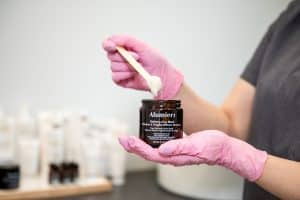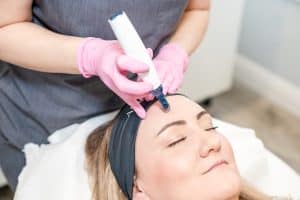
Is Laser Hair Removal Worth the Investment?
Is Laser Hair Removal Worth the Investment? Delving into the Value of Laser Hair Removal: Assessing Treatment Worth Laser hair removal has become a popular
blog post
Peach fuzz, the delicate, almost translucent hair that graces our faces, is a topic that often raises questions, particularly when it comes to removing it. Many individuals wonder whether removing peach fuzz will result in stubbly regrowth, causing concern about the appearance of their skin. Let’s explore this common query to understand the truth behind it.
Peach fuzz is the fine, light hair that commonly appears on areas of the face, such as the cheeks, upper lip, and chin. Unlike the thicker, darker hairs found elsewhere on the body, peach fuzz is soft to the touch and barely noticeable in most cases. Its delicate nature makes it less prone to causing irritation or discomfort compared to coarser hairs.
Various methods are available for removing peach fuzz, each with its own advantages and considerations:
Shaving: Using a razor or facial razor to gently trim peach fuzz at the surface of the skin is a quick and straightforward method. Contrary to popular belief, shaving does not cause peach fuzz to grow back thicker or darker. Dermaplaning: This technique involves using a sterile blade to exfoliate the skin and remove both peach fuzz and dead skin cells. Dermaplaning can leave the skin feeling smooth and refreshed, providing an excellent canvas for makeup application. Waxing: Applying wax to the skin and swiftly removing it to pull out peach fuzz from the root can provide longer-lasting results compared to shaving. However, waxing may cause discomfort and irritation for some individuals. Alkaline Wash: Alkaline wash is a chemical depilatory method that dissolves peach fuzz at the follicle level. This treatment offers long-lasting results with minimal discomfort, making it a popular choice for peach fuzz removal.
There is a common misconception that removing peach fuzz will cause it to grow back thicker, darker, or stubbly. However, this belief is not supported by scientific evidence. Peach fuzz regrowth is influenced by various factors, including genetics, hormones, and hair growth cycles, rather than the method of removal.
Genetics: Genetic factors play a significant role in determining the thickness, colour, and growth pattern of peach fuzz. Some individuals may naturally have finer or sparser peach fuzz, while others may have more noticeable regrowth. Hormones: Fluctuations in hormone levels, such as those experienced during puberty, pregnancy, or menopause, can affect hair growth patterns, including peach fuzz. Changes in hormone levels may result in alterations to the texture or density of peach fuzz over time. Hair Growth Cycles: Peach fuzz, like all hair, follows a natural growth cycle that includes phases of growth, transition, and rest. The length and thickness of peach fuzz regrowth may vary depending on where it is in the growth cycle at the time of removal.
While peach fuzz regrowth is a natural process, there are steps that can be taken to minimise the appearance of stubble and maintain smooth, hair-free skin:
Regular Exfoliation: Exfoliating the skin regularly can help prevent the buildup of dead skin cells and trapped hairs, reducing the likelihood of stubbly regrowth. Gentle exfoliation with a soft scrub or chemical exfoliant can promote smoother, more even skin texture. Moisturising: Keeping the skin hydrated can help soften peach fuzz regrowth and reduce the appearance of stubble. Using a lightweight, non-comedogenic moisturiser can help maintain skin health and prevent dryness or irritation. Avoiding Harsh Hair Removal Methods: Some hair removal methods, such as waxing or depilatory creams, can cause irritation or ingrown hairs, leading to a stubbly appearance. Choosing gentler methods, such as shaving or dermaplaning, can help minimise the risk of stubble and maintain smoother skin.
If you’re concerned about peach fuzz regrowth or experiencing unwanted stubble, it’s a good idea to consult with a dermatologist or licensed aesthetician. They can assess your individual needs and recommend personalised treatments or skincare products to help address your concerns.
The regrowth of peach fuzz is a natural process that varies from person to person. However, it doesn’t necessarily mean that it will return stubbly or thicker after removal. By understanding the factors that influence peach fuzz regrowth and following proper skincare practices, you can maintain smooth, hair-free skin without the worry of stubble. Whether you choose shaving, dermaplaning, waxing, or alkaline wash, there are options available to help you achieve your desired results and feel confident in your skin.
Book your consultation & patch test today.

Is Laser Hair Removal Worth the Investment? Delving into the Value of Laser Hair Removal: Assessing Treatment Worth Laser hair removal has become a popular

Is A Chemical Peel Worth It? Unlocking the Benefits of Chemical Peels: Evaluating Treatment Worth Chemical peels have long been a staple in skincare regimens,

What is the Success Rate of Microneedling? Exploring Microneedling Success: Understanding Treatment Efficacy Microneedling has garnered attention as a promising skincare treatment, praised for its

Is Microneedling Actually Good For Your Skin? Unveiling the Benefits of Microneedling: A Closer Look at Skincare Advantages Microneedling has emerged as a popular skincare